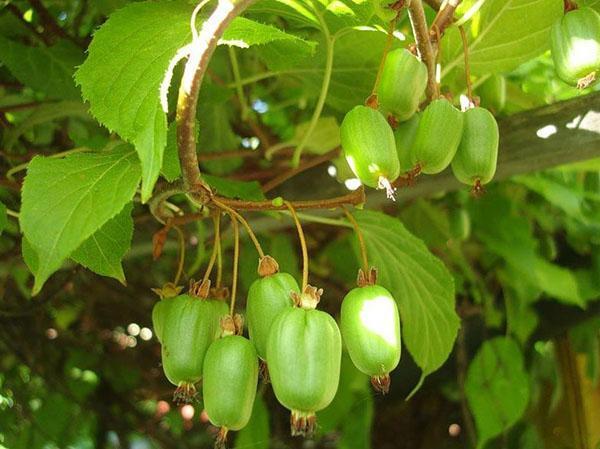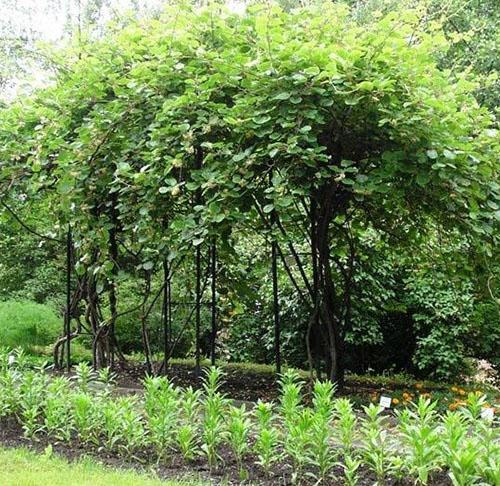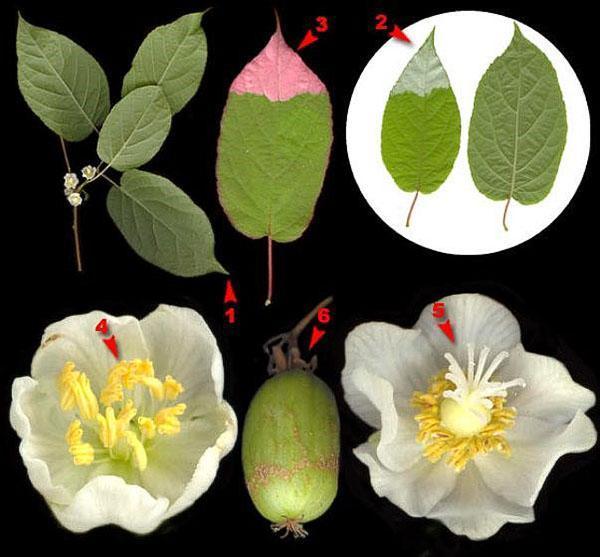Features of the variety, planting and care of the actinidia kolomikta
 Actinidia is a liana-like plant with a powerful tree-like stem and a large number of large leaves. Among all varieties, actinidia kolomikta is widespread, planting and caring for which is relevant for the Moscow region and the northern part of Russia. This plant is also known as the northern grape, which it received as a result of the external resemblance of the fruit to the grape bunches. It is grown not only for obtaining berries, but also as an ornamental plant.
Actinidia is a liana-like plant with a powerful tree-like stem and a large number of large leaves. Among all varieties, actinidia kolomikta is widespread, planting and caring for which is relevant for the Moscow region and the northern part of Russia. This plant is also known as the northern grape, which it received as a result of the external resemblance of the fruit to the grape bunches. It is grown not only for obtaining berries, but also as an ornamental plant.
Features of actinidia kolomikta

The sex of actinidia does not change throughout the entire growing period. To obtain a high-quality and rich harvest, it is recommended to keep 5 female roots and 2 male roots in one area.
 Actinidia kolomikta, the fruits of which have a high content of ascorbic acid, will be very useful for humans. For 100 g of berries, there are more than 1,000 mg of this valuable vitamin. To get your daily dose of vitamin C, it is enough to eat two actinidia berries. From this it follows that only 1.5 kg of berries are enough for a person for a year.
Actinidia kolomikta, the fruits of which have a high content of ascorbic acid, will be very useful for humans. For 100 g of berries, there are more than 1,000 mg of this valuable vitamin. To get your daily dose of vitamin C, it is enough to eat two actinidia berries. From this it follows that only 1.5 kg of berries are enough for a person for a year.
In the comments of gardeners, it is noted that this plant is not affected by pests, they bypass it, which means that you will not have to spend additional funds on the fight.
Actinidia kolomikta, variety description:
- A perennial plant with a climbing trunk, capable of wrapping around a support up to 8 m high.
- The lifespan reaches 30 years.
- The flowering period is late - mid-June. The temperature for normal flowering should not be below 0 degrees. The first flowers appear only at 4–5 years of plant life. Male specimens have staminate flowers, and female flowers also have a large pistil.
- Fruit ripening occurs in September - early October. Ripe fruits are dark green in color with a soft and delicate texture. The yield from one shrub is about 1-2 kg.
- The taste is sweet and sour or sweet, with a pineapple flavor.
Seat selection
 Before choosing a place for planting actinidia kolomikt, it is necessary to study its main features:
Before choosing a place for planting actinidia kolomikt, it is necessary to study its main features:
- the liana constantly stretches upward, some specimens reach a height of 8 meters;
- the root system of the plant is close to the surface.
Based on these features, you need to choose a place for growth. For these purposes, slightly shaded areas are ideal, in which there will be a lot of space for the free growth of the plant upwards. Under favorable conditions, multiple side shoots will form on it. Actinidia does not like overdried soils, therefore for watering you need to watch especially carefully.
The best option is to plant actinidia along fences or next to any buildings. In this case, you will not only get useful berries, but also get an ornamental plant for decorating a fence.The only thing to consider is the location of the drain, since the plant does not tolerate waterlogging, just like overdried soils.
It is not advisable to plant actinidia next to garden trees, as it will simply clog them. The minimum distance between liana and trees should be about 6-7 m.
Soil requirements
 Actinidia grows well in soil with a low content of components such as nitrogen and phosphorus. However, it is better to refuse breeding vines on alkaline soils, this type is absolutely not suitable for her. The best option is acidic or slightly acidic soils, possibly neutral. The structure of the soil should be loose, but not sandy. Clay soils are also not suitable for growing this crop.
Actinidia grows well in soil with a low content of components such as nitrogen and phosphorus. However, it is better to refuse breeding vines on alkaline soils, this type is absolutely not suitable for her. The best option is acidic or slightly acidic soils, possibly neutral. The structure of the soil should be loose, but not sandy. Clay soils are also not suitable for growing this crop.
In places with a close occurrence of groundwater, it is not recommended to plant actinidia, since excessive moisture can harm it.
Planting actinidia kolomikta
 The actinidia variety Kolomikta is very popular in Siberia. Planting can be done both in spring and autumn, after frosts or before their onset.
The actinidia variety Kolomikta is very popular in Siberia. Planting can be done both in spring and autumn, after frosts or before their onset.
For planting actinidia, a pit is prepared (50 * 50 * 50), with preliminary laying of the drainage layer. It is customary to use gravel, crushed stone or broken brick for it. Such a layer should be at least 10 cm. After it, the garden soil is filled up, with layers of dried humus.
If there is still heavy soil on the site, sand is added to the drainage layer. You can also add to the garden soil ash (1 kg), superphosphate (0.2 kg) and potassium sulfate (0.1 kg).
Having covered the hole with earth, a small mound is formed in its center, in which an actinidia seedling is placed. In order for the young roots not to dry out and not be attacked by pests, they are dipped in a clay mash before planting.
At the end of planting work, the seedling is watered with water (at the rate of 2 buckets per 1 bush.), And the earth around it is compacted a little. In this case, the root collar should be flush with the ground surface.
A hole around the bush should not be made to exclude the accumulation of rainwater in it.
Caring for actinidia kolomikta
To raise yields and form a decorative type of plant, you need to properly care for it.
Actinidia kolomikta, care and its main stages:
- Watering is frequent, but without the formation of stagnant water. It is necessary to constantly maintain soil moisture, since the roots of the plant are shallow. For normal growth of the vegetative part of the plant, moist air is required, therefore, in hot weather, it is recommended to spray the leaves with water, preferably twice a day, in the morning and in the evening.
- Plant feeding is carried out in early summer. For this, an infusion of mullein is used, diluted with water in a ratio of 1:10. You can also use other types mineral fertilizers.
- In order for the soil not to dry out, it is recommended to mulch it using different methods. The simplest and most effective way is to cover the surface with sawdust.
- The variety of actinidia kolomikta, planting and care in the Moscow region and Siberia also provides for its shelter for the winter period.
Pruning actinidia and what it is for
 Pruning of a plant is carried out immediately after its flowering or in late autumn, after all the leaves have fallen off. In the spring, during the period of juice production, pruning is not recommended, since the plant, due to loss of juice, may weaken, or even die. Pruning actinidia involves thinning the plant as well as cutting out weak and dead branches.
Pruning of a plant is carried out immediately after its flowering or in late autumn, after all the leaves have fallen off. In the spring, during the period of juice production, pruning is not recommended, since the plant, due to loss of juice, may weaken, or even die. Pruning actinidia involves thinning the plant as well as cutting out weak and dead branches.
Forming actinidia kolomikta
 Growing actinidia kolomikta and caring for it also imply its molding, the variety of which depends on the region where it grows, the place of planting and the type of trellis.
Growing actinidia kolomikta and caring for it also imply its molding, the variety of which depends on the region where it grows, the place of planting and the type of trellis.
In the middle lane actinidia is grown in the form of a bush, located on a trellis, by fan-forming. To do this, choose 3-4 main, vertical shoots, which will be the fan sleeves.In the fall, after the leaves fall off, their top is pinched off to the level of the stiff vine, due to which lateral branches will grow next year. Having chosen the most powerful of these shoots, they are tied to trellis, with direction in different directions.
The next year, shortened branches grow, ready for fruiting. They are tied up in an upright position. A year later, shoots will appear on them again, which will need to be tied up already in a horizontal position, spreading them in different directions. Shoots that have already fruited are recommended to be shortened by 5 buds, counting from the top berry.